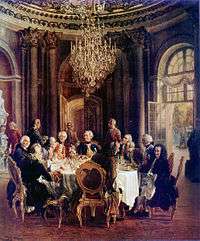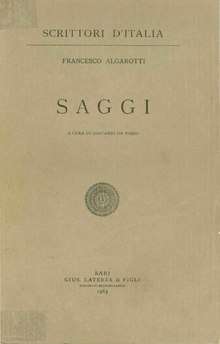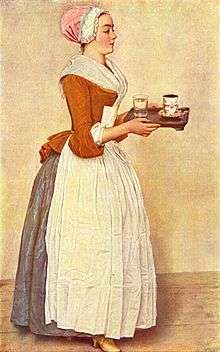Francesco Algarotti
Count Francesco Algarotti (11 December 1712 – 3 May 1764) was a Venetian polymath, philosopher, poet, essayist, anglophile, art critic and art collector. He was a man of broad knowledge, an expert in Newtonianism, architecture and music and a friend of most of the leading authors of his times: Voltaire, Jean-Baptiste de Boyer, Marquis d'Argens, Pierre-Louis de Maupertuis and the atheist Julien Offray de La Mettrie. Lord Chesterfield, Thomas Gray, George Lyttelton, Thomas Hollis, Metastasio, Benedict XIV and Heinrich von Brühl were among his correspondents.[1]
Francesco Algarotti | |
|---|---|
.jpg) Portrait by Jean-Étienne Liotard (1745), Rijksmuseum | |
| Born | 11 December 1712 |
| Died | 3 May 1764 (aged 51) |
| Nationality | Venetian |
| Occupation | Philosopher |
Early life
Algarotti was born in Venice as the son of a rich merchant. His father and uncle were art collectors. Unlike his older brother Bonomo he did not step into the company, but decided to become an author. Francesco studied natural sciences and mathematics in Rome and Bologna under Francesco Maria Zanotti and in 1728 he experimented with optics. (Zanotti became a lifelong friend.) First he travelled in the North of Italy, but moved to Florence, and Rome. At the age of twenty, he went to Cirey and Paris, where he became friendly with Voltaire and Émilie du Châtelet.[2] Two years later he was in London, where he was made a fellow of the Royal Society. He became embroiled in a lively bisexual love-triangle with the politician John Hervey, and Lady Mary Wortley Montagu.[3] Algarotti left for Italy and finished his Neutonianismo per le dame ("Newtonism for Ladies") (1737 – dedicated to Bernard le Bovier de Fontenelle) – a work consisting of information on astronomy, physics, mathematics, women and science and education.
In the meantime Algarotti had made acquaintance with Antiochus Kantemir, a Moldavian diplomat, poet and composer.[4] He was invited to visit Russia for the wedding of Duke Anthony Ulrich of Brunswick.[5] In 1739 he left with Lord Baltimore from Sheerness to Newcastle upon Tyne. Because of a heavy storm the ship sheltered in Harlingen. Algarotti was discovering "this new city", which he called the great window ... to which Russia looks on Europe.[6][7] Returning from Saint Petersburg, they visited Frederick the Great in Rheinsberg. Algarotti had obligations in England and came back the year after. Then Algarotti went together with Frederick to Königsberg where he was crowned.
Frederick, who was impressed with this walking encyclopedia, made him and his brother Bonomo Prussian counts in 1740. Algarotti accompanied Frederick to Bayreuth, Kehl, Strasbourg and Moyland Castle where they met with Voltaire, who was taking baths in Kleve for his health.[9] In 1741 Algarotti went to Turin as his diplomat. Frederick had offered him a salary, but Algarotti refused. First, he went to Dresden and Venice, where he bought 21 paintings, a few by Jean-Étienne Liotard and Giovanni Battista Tiepolo for the court of Augustus III of Poland.[10][11] Algarotti did not succeed in inducing the Kingdom of Sardinia to launch a treacherous attack upon Austria.[12]
Algarotti and the other arts

Algarotti's choice of works reflects the encyclopedic interests of the Neoclassic era; he was uninterested in developing a single unitary stylistic collection, and envisioned a modern museum, a catalog of styles from across the ages. For contemporary commissions, he wrote up a list of paintings he recommended commissioning, including history paintings from Tiepolo, Pittoni, and Piazzetta; scenes with animals from Castiglione, and veduta with ruins from Pannini. He wanted "suggetti graziosi e leggeri" from Balestra, Boucher, and Donato Creti.[14] Other artists he supported were Giuseppe Nogari, Bernardo Bellotto, and Francesco Pavona.
In 1747 Algarotti went back to Potsdam and became court chamberlain, but left to visit the archeological diggings at Herculaneum.[15] In 1749 he moved to Berlin. Algarotti was involved in finishing the architectural designs of Georg Wenzeslaus von Knobelsdorff who had fallen ill. In February 1753, after several years residing in Prussia, he returned to Italy, living most of the time in Bologna. In 1759 Algarotti was involved in a new opera-style in the city of Parma. He influenced Guillaume du Tillot and the Duke of Parma.

Algarotti's Essay on the Opera (1755) was a major influence on the librettist Carlo Innocenzo Frugoni and the composer Tommaso Traetta, and in the development of Gluck's reformist ideology.[16] Algarotti proposed a heavily simplified model of opera seria, with the drama pre-eminent, instead of the music, ballet or staging. The drama itself should "delight the eyes and ears, to rouse up and to affect the hearts of an audience, without the risk of sinning against reason or common sense". Algarotti's ideas influenced both Gluck and his librettist Calzabigi, writing their Orfeo ed Euridice.[17]
In 1762 Algarotti moved to Pisa, where he died of tuberculosis. Frederick the Great, who several times had needed Algarotti for writing texts in Latin, sent in a text for a monument to his memory on the Campo Santo.
Works

- Bibliography and Inventory of all known letters at Algarotti Briefdatenbank der Universitätsbibliothek Trier (in French)
- Correspondence with Frederick the Great at Digitale Ausgabe der Universitätsbibliothek Trier (in French)
- Il newtonianismo per le dame, 1737. The International Centre for the History of Universities and Science (CIS), University of Bologna
- "Saggio sopra la pittura"[18][19]
- "An essay on architecture" (1753).[20]
- "Letters military and political" (1782).[21]
- "Essai sur la durée des règnes des sept rois de Rome"
- "Essai sur l'empire des Incas"
- Algarotti, Francesco (1783). Calamo Ludimus (Translation of Treatise first published in 1744, Livorno) (ed.). The modern art of love; or The congress of Cythera. G. Kearsley, No. 46, Fleet Street, London.
Francesco Algarotti.
- Algarotti, Francesco (1739). Sir Isaac Newton's Philosophy Explained for the use of Ladies, in six dialogues on Light and Colours. (Translation; Volume I.). E. Cave, St. John's-Gate, London.
- Algarotti, Francesco (1764). Presso Marco Coltellini, Livorno (ed.). Saggio sopra la pittura.[22]
- Algarotti, Francesco (1756). Saggio del Conte Algarotti sull'Architettura e sulla Pittura. Societa Tipografica de' classici Italiani, Contrada di S. Margherita #1118, Milan, Italy.
- Algarotti, Francesco (1755). Saggio sopra L'Opera in Musica. Ex donat. Molliana.
Gallery
- Algarotti tombstone on the left in neo-classical style
 Tomb of Algarotti in Camposanto di Pisa, designed by Mauro Antonio Tesi
Tomb of Algarotti in Camposanto di Pisa, designed by Mauro Antonio Tesi Algarotti was involved in the design of the Französische Kirche in Potsdam; picture taken just after the war.
Algarotti was involved in the design of the Französische Kirche in Potsdam; picture taken just after the war. Francesco Algarotti by Giovanni Boggi, who copied a portrait by J. É. Liotard
Francesco Algarotti by Giovanni Boggi, who copied a portrait by J. É. Liotard Domenico Michelessi, Memorie intorno alla vita e agli scritti del conte Francesco Algarotti, 1770
Domenico Michelessi, Memorie intorno alla vita e agli scritti del conte Francesco Algarotti, 1770
References
- Eighteenth Century Bibliography. "Francesco Algarotti Bibliography". C18.com. Retrieved 18 February 2012.
- In 1740 Voltaire called him the Venetian Socrates, may be his "cher cygne de Padoue" ("dear swan of Padua").
- Rictor Norton, "John, Lord Hervey: The Third Sex", The Great Queens of History. Updated 8 August 2009
- 'By the Banks of the Neva': Chapters from the Lives and Careers of the ... By Anthony Glenn Cross
- Algarotti dedicated six of the letters that made up his Viaggi di Russia to John Hervey; the others to Scipio Maffei.
- The Petrine Revolution in Russian Architecture By James Cracraft
- Cultures of Forgery: Making Nations, Making Selves
- Walter Koschatzky (Hrsg.): Maria Theresia und ihre Zeit, p. 313. Zur 200. Wiederkehr des Todestages. Ausstellung 13. Mai bis 26. Oktober 1980, Wien, Schloß Schönbrunn. Im Auftrag der Österreichischen Bundesregierung veranstaltet vom Bundesministerium für Wissenschaft und Forschung, Gistel, Wien 1980.
- MacDonogh, G. (1999) Frederick the Great, pp. 142–145.
- The Empire of Flora by Giovanni Battista Tiepolo at Legion of Honor
- Eighteenth-century Venetian Art at Hermitage Amsterdam
- MacDonogh, G. (1999) Frederick the Great, p. 191.
- Tiepolo's Cleopatra by Jaynie Anderson
- Tiepolo's Cleopatra Door, by Jaynie Anderson, p. 109
- MacDonogh, G. (1999) Frederick the Great, p. 192.
- Orrey, p. 81
- Orrey, p. 83
- Algarotti, Conte Francesco (1764). Saggio sopra la pittura.
- Charles Harrison; Paul Wood (8 February 2001). Art in theory, 1648–1815: an anthology of changing ideas. ISBN 9780631200642.
- Cosmin Ungureanu, "Sia funzion la rappresentazione." Carlo Lodoli and the Crisis of Architecture
- letter is on Siege of Bergen op Zoom (1747).
- Art in Theory 1648–1815: An Anthology of Changing Ideas, Charles Harrison, Paul Wood, Jason Gaiger, eds.
Sources

- Haskell, Francis (1993). "Chapter 14". Patrons and Painters: Art and Society in Baroque Italy. 1980. Yale University Press. pp. 347–360.
- Laura Favero Carraro. "Francesco Algarotti". The Literary Encyclopedia. Ed. Robert Clark, Emory Elliott and Janet Todd.
- MacDonogh, G. (1999) Frederick the Great. New York: St. Martin's Griffin
- Orrey, Leslie; Milnes, Rodney (1987). Opera, a concise history. London: Thames and Hudson. ISBN 0-500-20217-6.
- Occhipinti, C. Piranesi, Mariette, Algarotti. Percorsi settecenteschi nella cultura figurativa europea. Roma, UniversItalia, 2013. ISBN 9788865074596
- Stanford University Databases
- Frieder von Ammon, Jörg Krämer, Florian Mehltretter (eds.): Oper der Aufklärung - Aufklärung der Oper. Francesco Algarottis "Saggio Sopra L'Opera in Musica" im Kontext. Mit einer kommentierten Edition der 5. Fassung des "Saggio" und ihrer Übersetzung durch Rudolf Erich Raspe. Berlin/Boston: De Gruyter 2017, ISBN 978-3-11-054209-7.
External links
- Catalogo dei quadri dei disegni e dei libri che trattano dell' arte del disegno della galleria del fu Sig. conte Algarotti in Venezia (1776)
- Online books by F. Algarotti at The Online Books Page.
- Francesco Algarotti's House in Venice
- Works by or about Francesco Algarotti in libraries (WorldCat catalog)
- in Tate Collection at Tate.org.uk
- How to become a renowned writer: Francesco Algarotti (1712—1764) and the uses of networking in eighteenth-century Europe by Smeall, Cheryl Lynn, Ph.D., McGill University (Canada), 2011, 449 pages; AAT NR77555
- All that glitters by Henk van Os
- Becoming a Scientist: Gender and Knowledge in Eighteenth-Century Italy by Paula Findlen
- Thomas Carlyle on Algarotti
- Rictor Norton, "John, Lord Hervey", section: "Swan of Padua".
- Francesco Algarotti (1739) Il Newtonianismo per le dame. – Linda Hall Library
